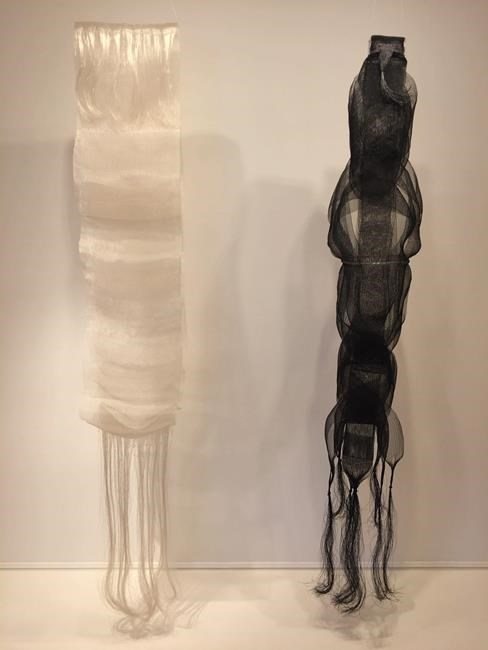
This photo taken on Dec. 2, 2016 shows nylon monofilament woven wall hangings "Ogawa II" (1969 - white) and "Nagare I" (1967 - black) by Berkeley, Calif., based 90-year-old fiber artist and weaver Kay Sekimachi. The pieces are part of the "Kay Sekimachi: Simple Complexity" exhibit the Craft and Folk Art Museum in Los Angeles, chronicling Sekimachi's decades-long career. The exhibit opened on Sept. 25, 2016, and runs through Jan. 8, 2017. (Solvej Schou via AP)
December 14, 2016 - 6:12 AM
LOS ANGELES - When 90-year-old artist Kay Sekimachi was a child in the San Francisco Bay Area, she drew, painted and made hundreds of dresses for her paper dolls. That love for textiles carried into adulthood.
Over a 65-year career, Sekimachi wove intricate sculptural art, from 3-D wall hangings woven out of nylon monofilament fishing line to fiber tubes, woven boxes, and bowls made of lace paper, maple leaves and other materials.
Fifty-five of the Berkeley-based artist's works form the exhibit "Kay Sekimachi: Simple Complexity" at the Craft and Folk Art Museum in Los Angeles. The exhibit runs through Jan. 8.
"She really is known as a master weaver," said curator Holly Jerger. "She's part of this overall movement that developed in the 1960s, where textiles went from mostly two-dimensional and functional to being a sculptural form. A lot of that was tied to the feminist movement as well, and women taking over those traditional practices but making them big and explosive and large-scale. Her work is more intimate."
From 1942 to 1944, Sekimachi and her first-generation Japanese-American parents were interned at detention camps in California and Utah. While there, Sekimachi took painting and origami classes. After the war, she studied at the California College of Arts and Crafts (now the California College of the Arts).
She bought her first loom in 1949, took weaving classes, and connected with a mentor, weaver and textile artist Trude Guermonprez. Guermonprez introduced Sekimachi to the architecture-driven Bauhaus art movement, and also to double weaving. Instead of just one warp — long threads stretched through the loom and woven through horizontal threads called the weft — double weaving uses two warps simultaneously to create a layered effect.
"Most of us weavers, we started by weaving things like placemats, hand towels, blankets, kitchen fabrics," Sekimachi said in an interview. "Trude opened my eyes and made me see that weaving could be much more than these functional things."
A friend whose mother worked for manufacturer DuPont sent Sekimachi samples in the mid-1950s of the nylon monofilament, and she put it on the loom, making a wall hanging. Eventually, she wove several layers at a time. The stiff but malleable monofilament layers could be pulled apart and sculpted.
In the exhibit, 1967's "Nagare I" hangs in the entrance like a beautifully strange, vertical sea creature, woven out of six undulating layers of nylon monofilament dyed jet black.
"It took me about an hour to weave an inch. I was weaving many, many layers," Sekimachi said.
In the '70s, she used a process called card weaving to make seamless fiber tubes. By threading vertical warp threads through cards or tablets with holes drilled through them, she created floor-to-ceiling tube hangings. The exhibit features 1974's "Marugawa I" and "Marugawa II" in twisty black and white natural linen, and 1978's "Marugawa IV" in orange, blue and natural colored linen.
"There's a crispness to linen when woven, and it has a lot of body," Sekimachi said.
When she started making woven boxes and bowls out of materials such as Japanese antique paper, leaves, lace paper and linen threads, she collaborated with her late husband Bob Stocksdale. He was a wood-turner who made wooden objects and bowls on a lathe. In the exhibit, their 1977 and 1999 "Marriage in Form" series combines Stocksdale's wooden bowl forms with Sekimachi's use of Kozo paper and hornet's-nest paper layered and laminated over them.
Inspiration for her first bowl came when some friends were making small jars or bottles out of hog intestines. "I thought, 'Gee whiz, if they can make these out of gut, why don't I make these out of paper?' I had a lot of Japanese paper at the time," Sekimachi said.
Her bowls made out of the pairing of just two maple leaves look delicate enough to break with a touch.
"They're surprisingly very strong, because the veins of the leaf are wood," she said. "The preparation — soaking them, getting them pliable — takes an hour. The actual pasting takes about half an hour. They dry overnight, and I would cover them tightly with Saran wrap so the leaves conform to the shape of the mould."
For newbies wanting to create artistic woven pieces, Sekimachi suggests taking a weaving class to learn the basics. It's helpful to be in art school and study the work of other artists. Apprenticing with a mentor or weaver is invaluable, she said.
At age 90, Sekimachi continues to work, including making woven jewelry that uses objects such as coral, shells and bone that she has found on trips to Hawaii.
"For people who are new to weaving, keep in mind that it does take time and patience and a lot of failures, even for the most experienced people, like Kay, to get to where they are," said Jerger. "Look at it like a journey, instead of just A to Z."
___
Craft and Folk Art Museum: http://cafam.org
___
Solvej Schou is on Twitter at https://twitter.com/solvej_schou
News from © The Associated Press, 2016